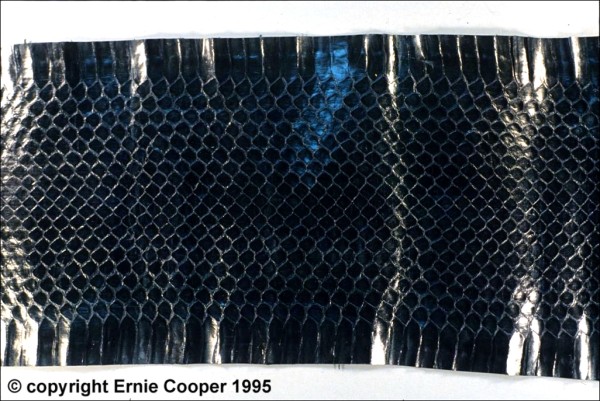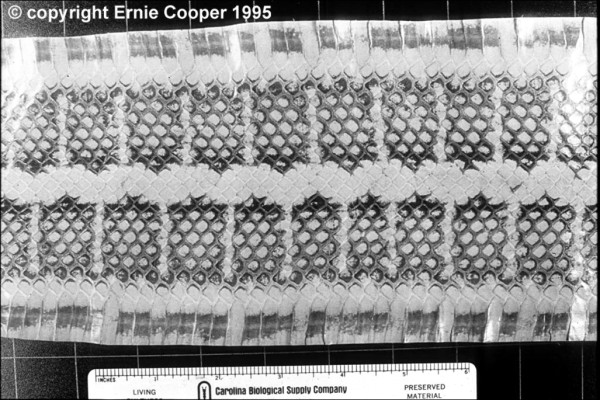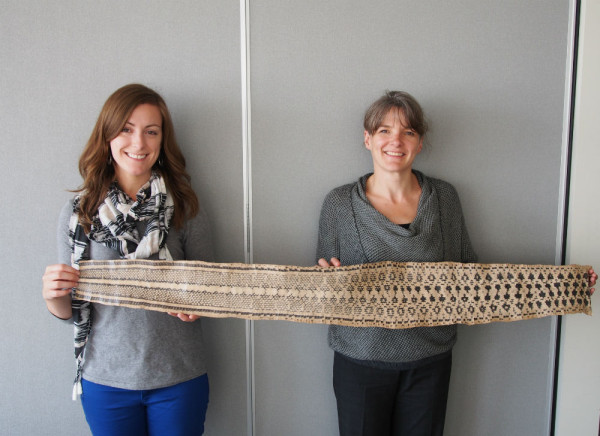Name that Snakeskin!
Periodically I receive requests from enforcement authorities for assistance with the identification of animal products. Over the years the most common requests I receive have been for help in identifying snakeskin. Last week, I was sent some pictures of skins that were detained for identification by a Canadian enforcement officer. Given that this is the year of the snake in the Chinese zodiac, I thought I’d share this story…
The items in question were whole tanned skins of Taiwan beauty snakes (Elaphe taeniura). This is a species that is common in the snakeskin trade but isn’t listed by CITES (although it probably should be). These are beautiful snakes with complex dark markings against a bright yellow background. But when a skin is tanned, all the pigments except the black (melanin) are lost. So what you end-up with is a white or tan skin with a pattern of black markings. A skin, therefore, will often look considerably different than a living specimen. This is why the typical field guides are of limited use for identification of snakeskin. However, the black markings can still be distinctive and in many cases will provide enough information for identification.
In this case, the skins still had the heads attached and I could see the characteristic short black stripes behind the eyes. The markings on the skin from the body were also easily recognizable: at the anterior (front) end there were dorsal saddles that look a little like dumbbells, and lateral blotches or rings. As you moved backwards down the skin these markings transitioned to lateral bands and then longitudinal stripes on the tail. These markings are distinctive to Elaphe taeniura.
This is a species of snake that I am very familiar with—although, sadly, I am mainly experienced with their skins rather than the live snakes. Back in 1995, I was part of a group tour of the RCMP forensic science lab in Edmonton Alberta. During the tour I spent some time in the Documents section chatting with the scientists about methods for determining whether a document had been forged. One of the topics they discussed was when documents had portions of the text blacked-out by a layer of ink. Different inks reflect different wavelengths of infrared light. So if the original text was covered by a different kind of ink, it was possible to use infrared light to see through the covering ink and read the original text. They took a document that had portions of the text blacked-out by felt pen to a piece of equipment called a Foster & Freeman Video Spectra Comparator, which looked a lot like a flatbed scanner attached to a computer screen. They slid the document into the machine and on the computer screen you could easily read the text under the felt pen markings.
I found this fascinating. One of the issues I was dealing with in those days was the challenge of identifying snakeskin that had been dyed black thereby obscuring the natural black markings. So I asked whether the technique could work on dyed snakeskin. They were a little surprised by the question and told me that would need a specimen of dyed snakeskin to try it. Well it just so happened that I had a black snakeskin rolled-up in my jacket pocket. So I pulled it out and handed it to them.
They gave me an odd look for a couple of seconds (I’m a bit used to getting that look from people) then slid the skin into the Video Spectra Comparator. And on the computer screen there were the clear, unmistakeable markings of Elaphe taeniura. The black dye was completely transparent to infrared light. It was totally cool!
Afterwards I experimented with the use of infrared photography as a method to identify dyed snakeskin. I found that if you photographed a black snakeskin product with infrared film, the resulting pictures would show only the natural markings of the skin and the black dye would be invisible. It was like magic!
Nowadays you don’t need to wait for infrared film to be developed. With the right digital camera and an infrared filter you can take a picture of a black snakeskin item and instantly see the natural pattern below the dye.
And I still think it is cool!




